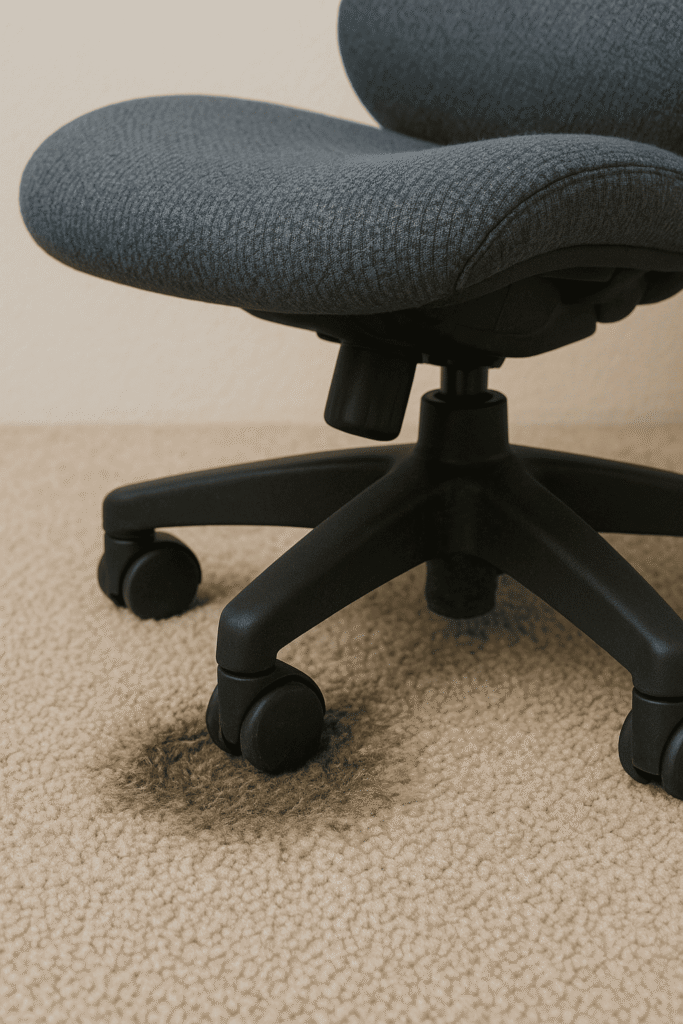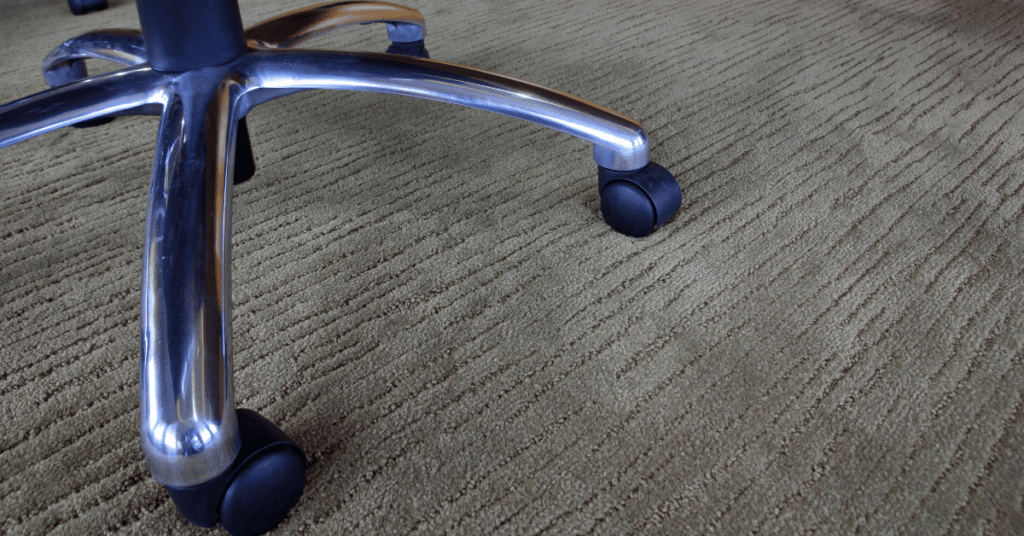Table of Contents
ToggleIntroduction
Most individuals don’t know that their office chair could leave visible scars, flattened fibers, or rough edges on their carpet. It’s wonderful how quickly something as simple as moving your chair back and forth can cause a lot of damage. Carpets are naturally weak, and without the right protection, the damage builds up slowly over time.
Why do you care? For one thing, a clean and fresh office makes you feel better, elevates your attitude, and helps you stay focused. Replacing carpet is also expensive, which is more crucial. The cost of installing new carpet in the US ranges from $3 to $11 per square foot, depending on the quality and the amount of work needed. That means that recarpeting a small room of 200 square feet can easily cost thousands of dollars. It will always cost a lot less to take precautions to avoid problems now than to pay for a full replacement later.
This article walks you through everything you need to know: why office chairs damage carpet, how different chair designs influence flooring, and which smart, economical solutions work best in your home office or professional workspace.
Why Office Chairs Damage Carpet

Five little wheels, called casters, support both you and your chair, putting hundreds of pounds of pressure on small spots that sink into carpet fibers and padding. This crushes the pile, leaves dents, and weakens the base. As you roll or swivel, caster edges twist and shear the fibers, turning light scuffs into visible marks.
Soft, high-pile carpets flatten and tangle quickly, while low-pile commercial carpets last longer but still wear down in one spot. Even dense carpet isn’t immune, rolling in the same area daily leaves grooves. No matter how plush or durable your rug is, your chair will wear it down unless you protect it.
Types of Office Chairs and Their Impact on Carpet
Moving Chairs vs. Fixed Chairs
Rolling office chairs damage carpets the most because they put pressure and friction on them every time they move. A chair that doesn’t move, like one without wheels, gets rid of the rolling friction, but it can still leave dents if it stays in one spot for too long.
If you don’t need to travel about a lot, you might want to get a stationary type with locking slides instead of wheels. Glides lie level on the carpet, which helps to distribute weight more evenly. They’re a good compromise for smaller work areas or lighter use.
Hard Plastic vs. Soft Rubber Wheels
Most office chairs have wheels made of durable nylon or plastic. These are good for tile or hardwood floors, but they dig into carpet fibers and wear down the surface over time. One of the best little modifications you can make is to switch to soft rubber or polyurethane wheels, which are often dubbed “rollerblade-style casters“
Soft casters bend a little when weight is put on them, so they hold on to the carpet instead of cutting into it. They roll silently, spread out the weight evenly, and cut down on wear and tear by a huge amount. After moving to these wheels, a lot of people discover that the marks under their chair fade or cease becoming worse.
Chair Weight and Base Design
Heavier chairs, like those with metal frames or extra features, exert additional stress on each caster. A robust, five-star base with a wide stance helps distribute the weight evenly. Some chairs even have bigger “carpet casters” that help spread the load and reduce friction.
If your chair feels heavy or sinks into the carpet, you might want to use wide rubber casters or a chair mat made for carpeted floors. Both help keep the carpet’s shape and look.
Preventive Measures for Carpet Protection
One of the easiest and best ways to protect your carpet is to use a chair mat. It evenly distributes your weight, keeps the casters from biting into the fabric, and makes moving around smoother and quieter. Mats also help keep dust, dirt, and spills from getting on your carpet, making it last longer. A decent mat protects your carpet and chair casters from damage, helps your carpet last longer, and saves you money on cleaning. Choose a tempered glass mat for a high-end look and strength that’s almost impossible to break, or a polycarbonate mat for durability and stiffness. Avoid thin vinyl mats, as they bend and break easily. For deep-pile carpet, pick a thicker mat with grippers on the bottom; for low-pile carpet, a smooth-back mat works well. While basic vinyl mats cost around $30- $50 and usually need replacement within a year, polycarbonate or glass mats costing $100 – $200 can last 5 to 10 years, making them a much better long-term investment than replacing damaged carpet.
Pick the Right Wheels for Your Chair
Change the casters on your chair if you don’t want a mat or want more protection. It only takes a few minutes to change hard plastic wheels to soft polyurethane carpet casters, but they will protect your floors for years. These soft casters roll silently and won’t tear up carpet fibers as regular hard ones do.
Chair mats provide better general protection against deep impressions and spills, while soft casters are best for reducing rolling friction and fiber wear. They also work better on mixed floors since they glide smoothly over carpet, hardwood, and tile without damaging or denting them.
Install Carpet-Safe Office Chairs
Choose or upgrade a chair that is made to protect carpets and support your body in a comfortable way. Many high-end office chairs now have wide, rubberized wheels that move smoothly and spread weight evenly, so they don’t leave dents in the carpet. Some high-end versions also have pressure-balanced frames and adjustable tilt systems that better disperse body weight, which puts less stress on both your back and your floors.
You can replace the casters with stationary glides that sit level on the carpet if you don’t need to move the chair. This is great for home offices where the chair doesn’t move much. Use caster cups or protective pads to keep heavy furniture from leaving permanent scars on the carpet. These little changes will protect your carpet and help you sit up straighter and healthier at the same time. Maintain a healthier, more stable sitting posture at the same time.
Maintenance and Rotation on a Regular Basis
Preventive habits are just as important as upgrading your hardware. Dirt and dirt stuck in carpet fibers behave like sandpaper on your wheels. To get rid of those particles, vacuum your work area at least once a week.
Turn your chair upside down and clean the wheels every few months. Take out any hair or lint that is knotted up and could slow down rolling or catch fibers.
Lastly, every three to six months, move your furniture or modify the location of your chair mat. This easy action makes wear spread out widely instead of focusing it in one busy area.
Put felt glides or pads under the legs of your chair when it’s not moving to stop pressure from building up in one spot. These minor changes can simply make your carpet last longer.
Add Some Area Rugs or Carpet Runners
Layering an area rug over the carpet offers flair and protection if you enjoy a pleasant, furnished workstation. Pick carpets with a low pile and tightly woven fibers so your wheels don’t sink in. Also, make sure the rug covers the whole area where you roll. It stays in place thanks to a backing that doesn’t slip.
A new trend in the U.S. is hybrid flooring protection, which combines the beauty of rugs with the strength of mats. These ornamental rug-mats are manufactured by attaching a stylish fabric layer to a solid core. They are both stylish and strong, so they are great if you want something that looks better than a clear plastic mat but is just as strong.
Use a carpet runner for lengthy, tight routes, like those between desks or printers. It can handle a lot of rolling and is easier and cheaper to replace than a whole carpet installation.
Why You Should Take Care of Your Carpet
Cleaning your carpet is more than just for looks; it’s also useful, cost-effective, and good for your back.
It keeps carpets looking excellent for longer by keeping the fibers from breaking or falling apart. A clean, smooth carpet makes your workstation look better, keeps dust from becoming trapped, and makes the air cleaner.
It also helps you save money. A chair mat, soft casters, and regular upkeep are all far cheaper than getting a new carpet.
Taking care of your carpet properly might even help your health and comfort. You don’t have to move in an odd way that hurts your back or knees when your office chair slides smoothly instead of getting stuck on torn fibers. You may also make your flooring and chair wheels last longer by eliminating dirt from grinding into the fibers.
In short, taking care of your carpet will make it more comfortable and save you money in the long run.
Conclusion
You may definitely have a nice carpet and a comfortable office chair, but you have to be careful about how you do it. We’ve talked about how caster pressure, friction, and fiber stress wear down carpets; how various wheels make a difference; and what you can do to avoid the damage before it starts.
Chair mats, soft casters, and simple care practices are all easy ways to change how your carpet ages. Putting these ideas together can make sure your home office stays both useful and stylish.
Start small today: To lessen concentrated pressure, switch to wheels that are appropriate for carpets, put down a chair mat, or move your desk around. If you act quickly, your carpet will stay bright and healthy for years without needing to be replaced or getting wheel ruts.
Frequently Asked Questions
What kind of wheels on a chair work best on carpet?
Soft polyurethane rollerblade-style casters are the best choice. They don’t catch or scratch fibers like hard plastic or metal wheels do, and they spread the weight evenly for smooth rolling.
How can I stop chairs from leaving stains or dents in the carpet?
Use a chair mat or change to soft casters. To keep the fibers from getting too compressed, add felt pads to chairs that don’t move, move them around every now and again, and vacuum them often.
Do you really need a carpet protector for your office chair?
Yes. A carpet protector stops friction, dents, and wear and tear over time. It costs a little bit up front, but it saves you hundreds later.
What is the difference between a rug and a chair mat?
A mat gives you a solid, flat surface to roll on and keeps dents from happening. A rug can offer color and flair, but it needs to be low-pile and not slip. Some people put a transparent mat on top of a rug to protect it and make it look better.
How often should I replace my office chair mat?
Polycarbonate or glass mats of good quality can last five years or more. You might have to replace cheaper PVC mats after two to three. For continuing protection of your carpet, replace them when they get dings, cracks, or curls.
Protect your investment by keeping your workspace clean and your carpet looking new.
Shop today to upgrade your office chair, wheels, and mats—and give your carpet the long life it deserves.


